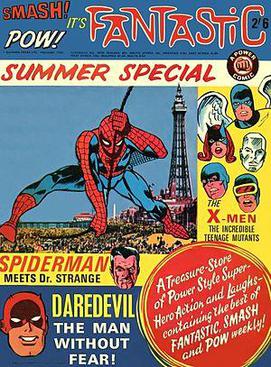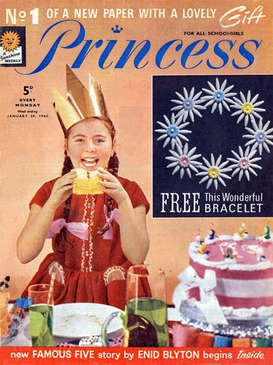Joseph Leo Baxendale was an English cartoonist and publisher. Baxendale wrote and drew several titles. Among his best-known creations are the Beano strips Little Plum, Minnie the Minx, The Bash Street Kids, and The Three Bears.

A British comic is a periodical published in the United Kingdom that contains comic strips. It is generally referred to as a comic or a comic magazine, and historically as a comic paper.

Marvel UK was an imprint of Marvel Comics formed in 1972 to reprint US-produced stories for the British weekly comic market. Marvel UK later produced original material by British creators such as Alan Moore, John Wagner, Dave Gibbons, Steve Dillon, and Grant Morrison.
The Amalgamated Press (AP) was a British newspaper and magazine publishing company founded by journalist and entrepreneur Alfred Harmsworth (1865–1922) in 1901, gathering his many publishing ventures together under one banner. At one point the largest publishing company in the world, AP employed writers such as Arthur Mee, John Alexander Hammerton, Edwy Searles Brooks, and Charles Hamilton. Its subsidiary, the Educational Book Company, published The Harmsworth Self-Educator, The Children's Encyclopædia, and Harmsworth's Universal Encyclopaedia. The company's newspapers included the Daily Mail, the Daily Mirror, The Evening News, The Observer, and The Times. At its height, AP published over 70 magazines and operated three large printing works and paper mills in South London.

TI Media was a consumer magazine and digital publisher in the United Kingdom, with a portfolio selling over 350 million copies each year. Most of its titles now belong to Future plc.

Lion was a weekly British comics periodical published by Amalgamated Press from 23 February 1952 to 18 May 1974. A boys' adventure comic, Lion was originally designed to compete with Eagle, the popular weekly comic published by Hulton Press that had introduced Dan Dare. It debuted numerous memorable characters, including Captain Condor, Robot Archie, Paddy Payne and the Spider. Lion lasted for 1,156 issues before being merged with stablemate Valiant.

Valiant was a weekly British comics periodical published by Fleetway Publications and later IPC Magazines from 4 October 1962 to 16 October 1976. A boys' adventure comic, it debuted numerous memorable characters, including Captain Hurricane, The Steel Claw and Mytek the Mighty. Valiant lasted for 712 issues before being merged with stablemate Battle Picture Weekly.
TV Century 21, later renamed TV21, TV21 and Tornado, TV21 and Joe 90, and TV21 again, was a weekly British children's comic published by City Magazines during the latter half of the 1960s. Originally produced in partnership with Gerry and Sylvia Anderson's Century 21 Productions, it promoted the company's many science-fiction television series. The comic was published in the style of a newspaper of the future, with the front page usually dedicated to fictional news stories set in the worlds of Fireball XL5, Stingray, Thunderbirds, Captain Scarlet and the Mysterons and other stories. The front covers were also in colour, with photographs from one or more of the Anderson series or occasionally of the stars of the back-page feature.

Wham! was a weekly British comics magazine published by Odhams Press. It ran for 187 issues from 20 June 1964 to 13 January 1968, when it merged into its sister title Pow!

Pow! was a weekly British comic book published by Odhams Press' Power Comics imprint in 1967 and 1968. Like other Power Comics, Pow! featured a mixture of British strips with reprints from American Marvel Comics, including Spider-Man, Nick Fury, Agent of SHIELD and the Fantastic Four.

Fantastic was a weekly British comic book magazine published by Odhams Press under the Power Comics imprint. It first appeared on 18 February 1967, and with its 52nd issue on 10 February 1968 it merged with its sister title Terrific. The 89th and final issue of Fantastic appeared on 26 October 1968, after which it was merged into its sister title Smash!.

Smash! was a weekly British comic book, published initially by Odhams Press and subsequently by IPC Magazines, from 5 February 1966 to 3 April 1971. After 257 issues it merged into Valiant.

Power Comics was an imprint of the British comics publisher Odhams Press that was particularly notable for its use of material reprinted from American Marvel Comics. Appearing chiefly during the years 1967 and 1968, the Power Comics line consisted of five weekly titles: Wham!, Smash!, Pow!, Fantastic and Terrific. The first three of these titles were essentially traditional The Beano-style British comics papers, supplemented by a small amount of Marvel and DC Comics material, while Fantastic and Terrific were more magazine-like in style and were dominated by their Marvel superhero content.
Robin was a British weekly children's magazine published from 1953 to 1969, originally by Hulton Press. Robin was billed as "companion to Eagle, Girl, and Swift" and aimed at younger readers and pre-readers.
City Magazines was a British publisher of weekly comics and men's magazines that operated from the mid-1950s to the mid-1970s. The company's most notable publications were comics magazines based on licensed television properties, including TV Century 21 and Lady Penelope, both of which featured comics based on Gerry Anderson's Century 21 Productions Supermarionation shows.
British girls' comics flourished in the United Kingdom from the 1950s through the 1970s, before beginning to decline in popularity in the 1980s and 1990s. Publishers known for their girls' comics included DC Thomson and Fleetway/IPC. Most titles appeared weekly, with the content primarily in picture-story format. The majority of the stories were serialized, with two or three pages per issue, over eight to twelve issues. They were marketed toward young teen girls.

Princess was a British weekly girls' comic anthology published by Fleetway Publications and, later, IPC Magazines. The first version was published between 30 January 1960 and 16 September 1967, and featured a mix of comic strips, text stories and a large proportion of features; it was merged with Tina to form a new title - Princess Tina - after 399 issues.
C. Arthur Pearson Ltd was a British publisher of newspapers, periodicals, books, and comics that operated from 1890 to c. 1965. The company was founded by C. Arthur Pearson, later to be known as Sir Arthur Pearson, 1st Baronet.

Cursitor Doom is a fictional British comic book character who debuted in a self-titled comic strip in the 15 March 1969 issue of the anthology Smash!, published by IPC Magazines. Created by Ken Mennell, Cursitor Doom is a powerful mystic who protects Earth from supernatural threats.












